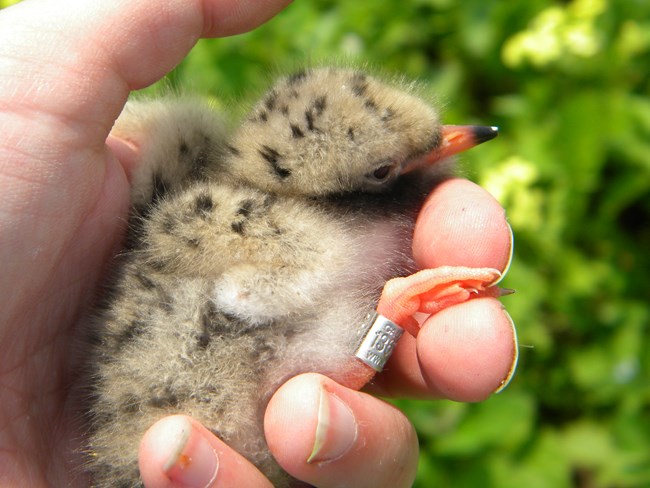
Photo/United States Fish and Wildlife Description The roseate tern (Sterna dougalliiis) is 12 to 16 inches in length and has a 31-inch wingspan. Roseate terns have a more abundant relative, the common tern (Sterna hirundo), both species are very similar looking and are often in groups together for nesting and staging. Roseate terns are a paler gray on their backs compared to the common tern and their tail feathers extend past the tips of their folded wings. They both have a black cap and orange-red legs, but roseate tern’s bills turn entirely black during the breeding season whereas common terns only have a black bill tip. Roseate terns get their name from the buffy pink belly they have at the very beginning of breeding season. Roseate and common terns can most easily be told apart by their calls. Roseate terns have a very iconic “chi-vik” that can be picked out of thousands of common terns calling their “kip-kip-kip" calls. Distribution and Abundance Along the Atlantic Coast The Northwest Atlantic population of roseate tern breeds from Long Island Sound north to Nova Scotia. This species also has a breeding population in the Caribbean. Buzzards Bay, Massachusetts is home to the largest breeding colonies in the Northwest Atlantic. In 2022, the state of Massachusetts had over 3,000 breeding pairs. Historically, roseate terns do not nest within the park boundary but do use park beaches during fall migration as stop-over and staging grounds. Hatches Harbor, Jeremy Point, and Nauset Marsh areas prove to be a significant stop-over for adult and juvenile terns before heading to South America for the winter. Breeding and Feeding Habits Roseate terns start showing up in Massachusetts in late April and begin laying eggs by mid-May. Like other tern species they nest in colonies, primarily within common tern colonies (their more abundant and more aggressive relative). Roseate terns nest on the ground, but they like to nest in denser vegetation and use dead and dried plants as nesting material. Females lay up to 2 eggs and they incubate them for 23 days while the male brings fish back to the nest for her. Chicks are downy when they hatch and typically stay around the nest site until they can fly at around 30 days. Roseate terns feed on forage fish. Their primary food source is sand lance. They are a plunge diving species and can been seen outside of their breeding colonies near sandbars, shoals, and inlets searching for predatory fish which drive smaller fish to the surface. They also consume herring, bluefish, mackerel, silversides, and anchovies. Sometimes roseate terns can be seen stealing fish from common terns, this is called kleptoparasitism. 
Photo/United States Fish and Wildlife Service Threats The threats that face roseate terns and other tern species include increased predation, habitat loss, and human disturbance. Climate change, sea-level rise, and increased storm frequency and intensity are also changing the beach ecosystem and have left humans and wildlife sharing a shrinking coastline. Threats extend outside of breeding grounds to their wintering grounds in South America where the species does not receive the same level of protection. Roseate terns are hunted in Africa and South America, and their eggs are harvested from colonies in the Carribean. Protections Roseate terns were listed as a federally endangered species in 1987. Their decline was in large part due to plume hunters at the beginning of the century. Today's threats are also human-caused from development and destruction of habitat. Under the Endangered Species Act their nesting grounds are protected in addition to the diligent land stewards that physically protect their habitat with symbolic fencing to keep curious bystanders out. Roseate terns are also protected under the Migratory Bird Treaty Act of 1918, which prohibits the take (including killing, capturing, selling, trading, and transport) of protected migratory bird species without prior authorization by the Department of Interior U.S. Fish and Wildlife Service. Cape Cod National Seashore helps to protect critical breeding habitat and migration stop-over areas for many species of shorebirds. The protections allow these species a place to rest and a place to raise their next generations. Things You Can Do to Help Protect Roseate Terns and Other Shorebirds
|
Last updated: January 31, 2023
